Business Environment Presentation and report
VerifiedAdded on 2023/06/18
|9
|2280
|98
AI Summary
This report covers different types of businesses with their legal structures including advantages and disadvantages of each, differentiation between the private and public ownership, assessment over UK policies related to competition, objectives & fiscal and monetary policy instruments the government could use to regulate the economy during the recession and its impact, and globalisation's impact on business, competition, and the economy.
Contribute Materials
Your contribution can guide someone’s learning journey. Share your
documents today.
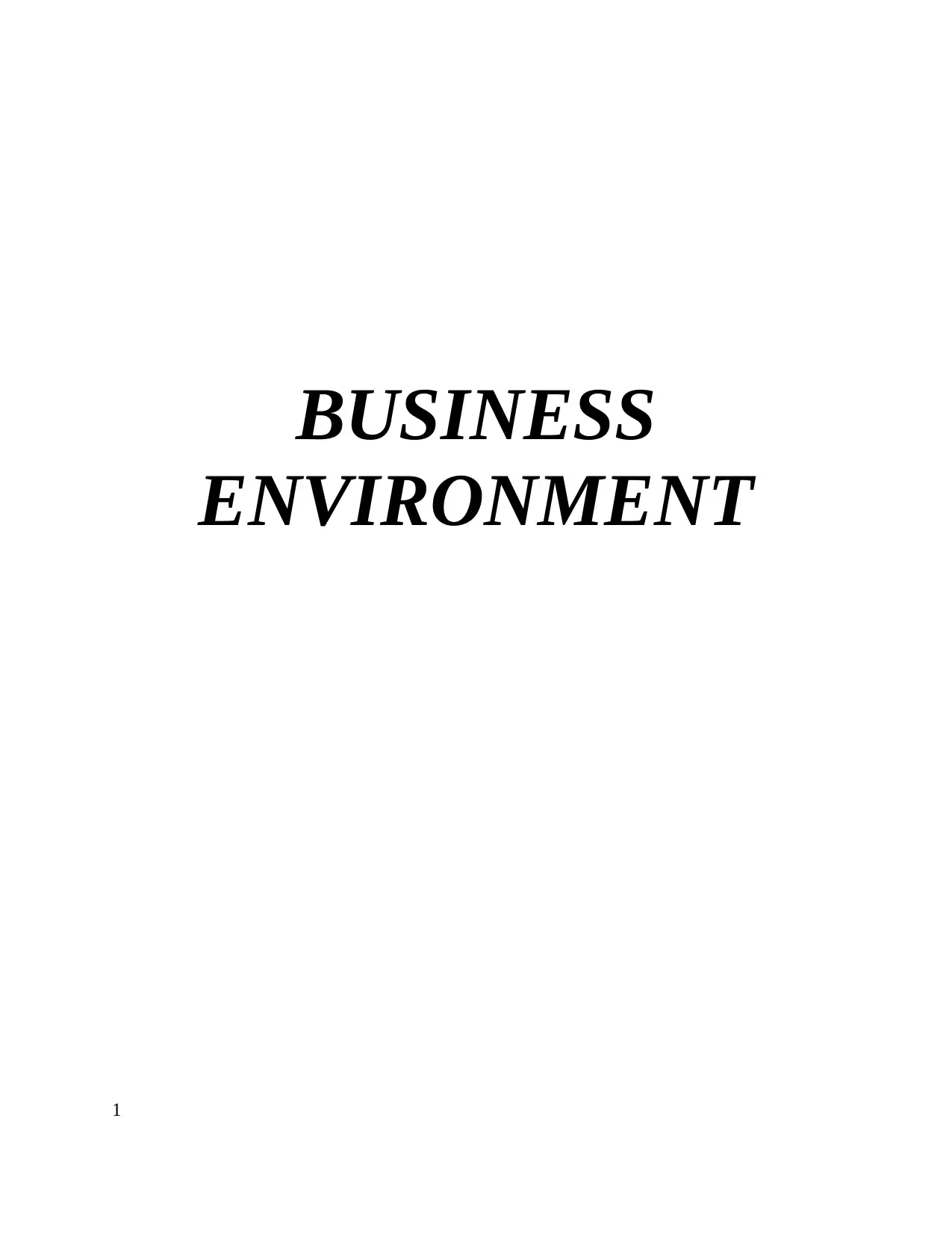
BUSINESS
ENVIRONMENT
1
ENVIRONMENT
1
Secure Best Marks with AI Grader
Need help grading? Try our AI Grader for instant feedback on your assignments.
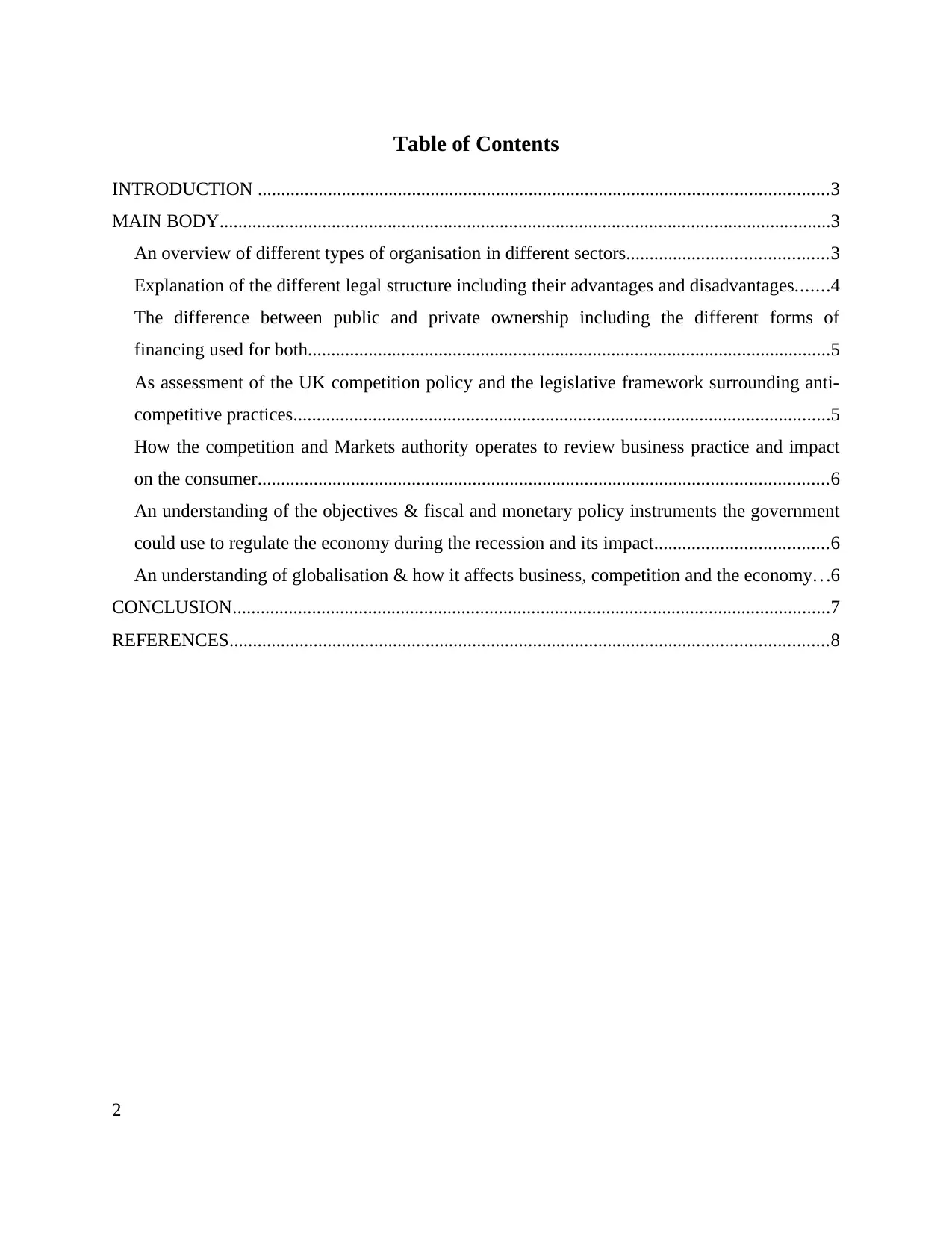
Table of Contents
INTRODUCTION ..........................................................................................................................3
MAIN BODY...................................................................................................................................3
An overview of different types of organisation in different sectors...........................................3
Explanation of the different legal structure including their advantages and disadvantages.......4
The difference between public and private ownership including the different forms of
financing used for both................................................................................................................5
As assessment of the UK competition policy and the legislative framework surrounding anti-
competitive practices...................................................................................................................5
How the competition and Markets authority operates to review business practice and impact
on the consumer..........................................................................................................................6
An understanding of the objectives & fiscal and monetary policy instruments the government
could use to regulate the economy during the recession and its impact.....................................6
An understanding of globalisation & how it affects business, competition and the economy. . .6
CONCLUSION................................................................................................................................7
REFERENCES................................................................................................................................8
2
INTRODUCTION ..........................................................................................................................3
MAIN BODY...................................................................................................................................3
An overview of different types of organisation in different sectors...........................................3
Explanation of the different legal structure including their advantages and disadvantages.......4
The difference between public and private ownership including the different forms of
financing used for both................................................................................................................5
As assessment of the UK competition policy and the legislative framework surrounding anti-
competitive practices...................................................................................................................5
How the competition and Markets authority operates to review business practice and impact
on the consumer..........................................................................................................................6
An understanding of the objectives & fiscal and monetary policy instruments the government
could use to regulate the economy during the recession and its impact.....................................6
An understanding of globalisation & how it affects business, competition and the economy. . .6
CONCLUSION................................................................................................................................7
REFERENCES................................................................................................................................8
2
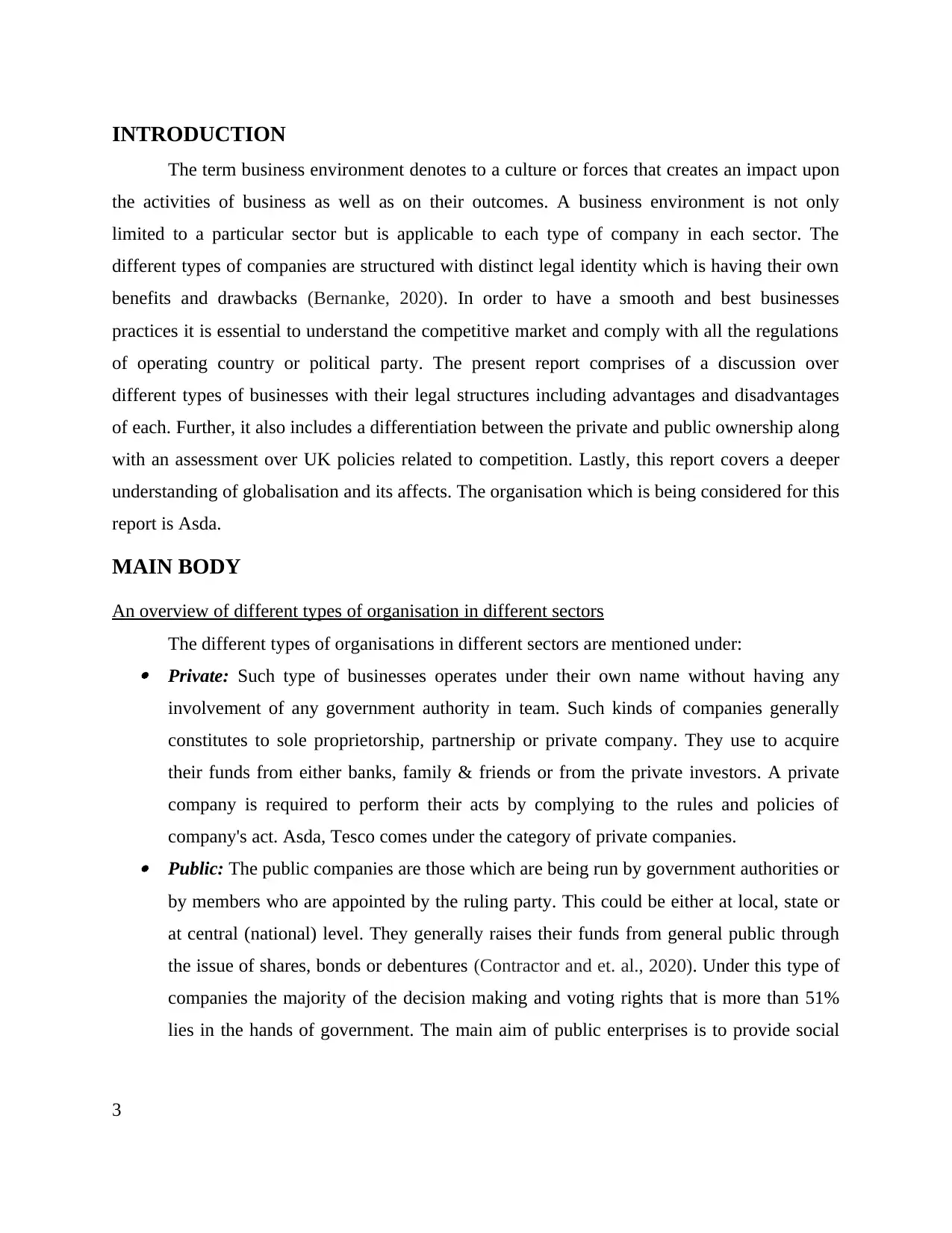
INTRODUCTION
The term business environment denotes to a culture or forces that creates an impact upon
the activities of business as well as on their outcomes. A business environment is not only
limited to a particular sector but is applicable to each type of company in each sector. The
different types of companies are structured with distinct legal identity which is having their own
benefits and drawbacks (Bernanke, 2020). In order to have a smooth and best businesses
practices it is essential to understand the competitive market and comply with all the regulations
of operating country or political party. The present report comprises of a discussion over
different types of businesses with their legal structures including advantages and disadvantages
of each. Further, it also includes a differentiation between the private and public ownership along
with an assessment over UK policies related to competition. Lastly, this report covers a deeper
understanding of globalisation and its affects. The organisation which is being considered for this
report is Asda.
MAIN BODY
An overview of different types of organisation in different sectors
The different types of organisations in different sectors are mentioned under: Private: Such type of businesses operates under their own name without having any
involvement of any government authority in team. Such kinds of companies generally
constitutes to sole proprietorship, partnership or private company. They use to acquire
their funds from either banks, family & friends or from the private investors. A private
company is required to perform their acts by complying to the rules and policies of
company's act. Asda, Tesco comes under the category of private companies. Public: The public companies are those which are being run by government authorities or
by members who are appointed by the ruling party. This could be either at local, state or
at central (national) level. They generally raises their funds from general public through
the issue of shares, bonds or debentures (Contractor and et. al., 2020). Under this type of
companies the majority of the decision making and voting rights that is more than 51%
lies in the hands of government. The main aim of public enterprises is to provide social
3
The term business environment denotes to a culture or forces that creates an impact upon
the activities of business as well as on their outcomes. A business environment is not only
limited to a particular sector but is applicable to each type of company in each sector. The
different types of companies are structured with distinct legal identity which is having their own
benefits and drawbacks (Bernanke, 2020). In order to have a smooth and best businesses
practices it is essential to understand the competitive market and comply with all the regulations
of operating country or political party. The present report comprises of a discussion over
different types of businesses with their legal structures including advantages and disadvantages
of each. Further, it also includes a differentiation between the private and public ownership along
with an assessment over UK policies related to competition. Lastly, this report covers a deeper
understanding of globalisation and its affects. The organisation which is being considered for this
report is Asda.
MAIN BODY
An overview of different types of organisation in different sectors
The different types of organisations in different sectors are mentioned under: Private: Such type of businesses operates under their own name without having any
involvement of any government authority in team. Such kinds of companies generally
constitutes to sole proprietorship, partnership or private company. They use to acquire
their funds from either banks, family & friends or from the private investors. A private
company is required to perform their acts by complying to the rules and policies of
company's act. Asda, Tesco comes under the category of private companies. Public: The public companies are those which are being run by government authorities or
by members who are appointed by the ruling party. This could be either at local, state or
at central (national) level. They generally raises their funds from general public through
the issue of shares, bonds or debentures (Contractor and et. al., 2020). Under this type of
companies the majority of the decision making and voting rights that is more than 51%
lies in the hands of government. The main aim of public enterprises is to provide social
3
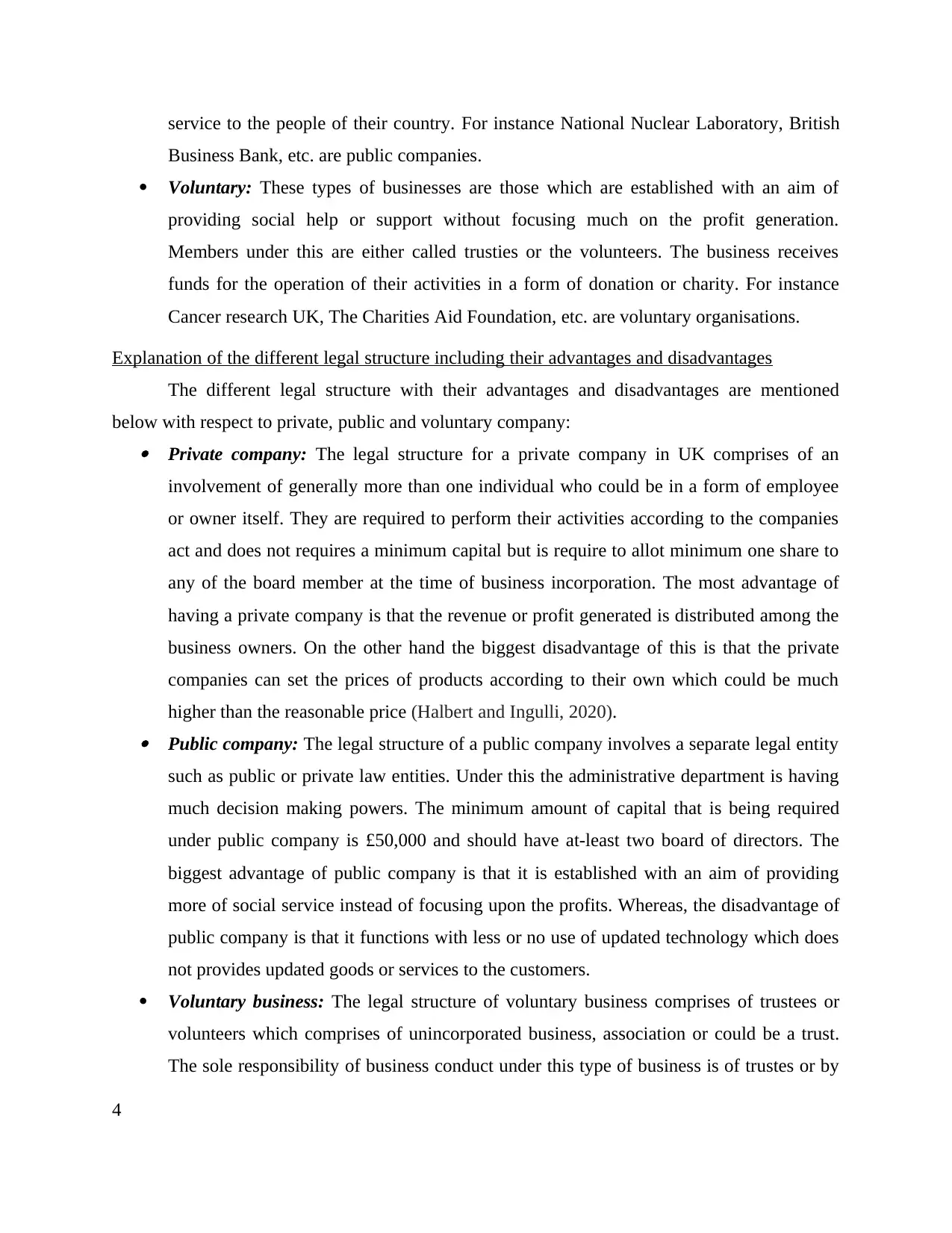
service to the people of their country. For instance National Nuclear Laboratory, British
Business Bank, etc. are public companies.
Voluntary: These types of businesses are those which are established with an aim of
providing social help or support without focusing much on the profit generation.
Members under this are either called trusties or the volunteers. The business receives
funds for the operation of their activities in a form of donation or charity. For instance
Cancer research UK, The Charities Aid Foundation, etc. are voluntary organisations.
Explanation of the different legal structure including their advantages and disadvantages
The different legal structure with their advantages and disadvantages are mentioned
below with respect to private, public and voluntary company: Private company: The legal structure for a private company in UK comprises of an
involvement of generally more than one individual who could be in a form of employee
or owner itself. They are required to perform their activities according to the companies
act and does not requires a minimum capital but is require to allot minimum one share to
any of the board member at the time of business incorporation. The most advantage of
having a private company is that the revenue or profit generated is distributed among the
business owners. On the other hand the biggest disadvantage of this is that the private
companies can set the prices of products according to their own which could be much
higher than the reasonable price (Halbert and Ingulli, 2020). Public company: The legal structure of a public company involves a separate legal entity
such as public or private law entities. Under this the administrative department is having
much decision making powers. The minimum amount of capital that is being required
under public company is £50,000 and should have at-least two board of directors. The
biggest advantage of public company is that it is established with an aim of providing
more of social service instead of focusing upon the profits. Whereas, the disadvantage of
public company is that it functions with less or no use of updated technology which does
not provides updated goods or services to the customers.
Voluntary business: The legal structure of voluntary business comprises of trustees or
volunteers which comprises of unincorporated business, association or could be a trust.
The sole responsibility of business conduct under this type of business is of trustes or by
4
Business Bank, etc. are public companies.
Voluntary: These types of businesses are those which are established with an aim of
providing social help or support without focusing much on the profit generation.
Members under this are either called trusties or the volunteers. The business receives
funds for the operation of their activities in a form of donation or charity. For instance
Cancer research UK, The Charities Aid Foundation, etc. are voluntary organisations.
Explanation of the different legal structure including their advantages and disadvantages
The different legal structure with their advantages and disadvantages are mentioned
below with respect to private, public and voluntary company: Private company: The legal structure for a private company in UK comprises of an
involvement of generally more than one individual who could be in a form of employee
or owner itself. They are required to perform their activities according to the companies
act and does not requires a minimum capital but is require to allot minimum one share to
any of the board member at the time of business incorporation. The most advantage of
having a private company is that the revenue or profit generated is distributed among the
business owners. On the other hand the biggest disadvantage of this is that the private
companies can set the prices of products according to their own which could be much
higher than the reasonable price (Halbert and Ingulli, 2020). Public company: The legal structure of a public company involves a separate legal entity
such as public or private law entities. Under this the administrative department is having
much decision making powers. The minimum amount of capital that is being required
under public company is £50,000 and should have at-least two board of directors. The
biggest advantage of public company is that it is established with an aim of providing
more of social service instead of focusing upon the profits. Whereas, the disadvantage of
public company is that it functions with less or no use of updated technology which does
not provides updated goods or services to the customers.
Voluntary business: The legal structure of voluntary business comprises of trustees or
volunteers which comprises of unincorporated business, association or could be a trust.
The sole responsibility of business conduct under this type of business is of trustes or by
4
Secure Best Marks with AI Grader
Need help grading? Try our AI Grader for instant feedback on your assignments.
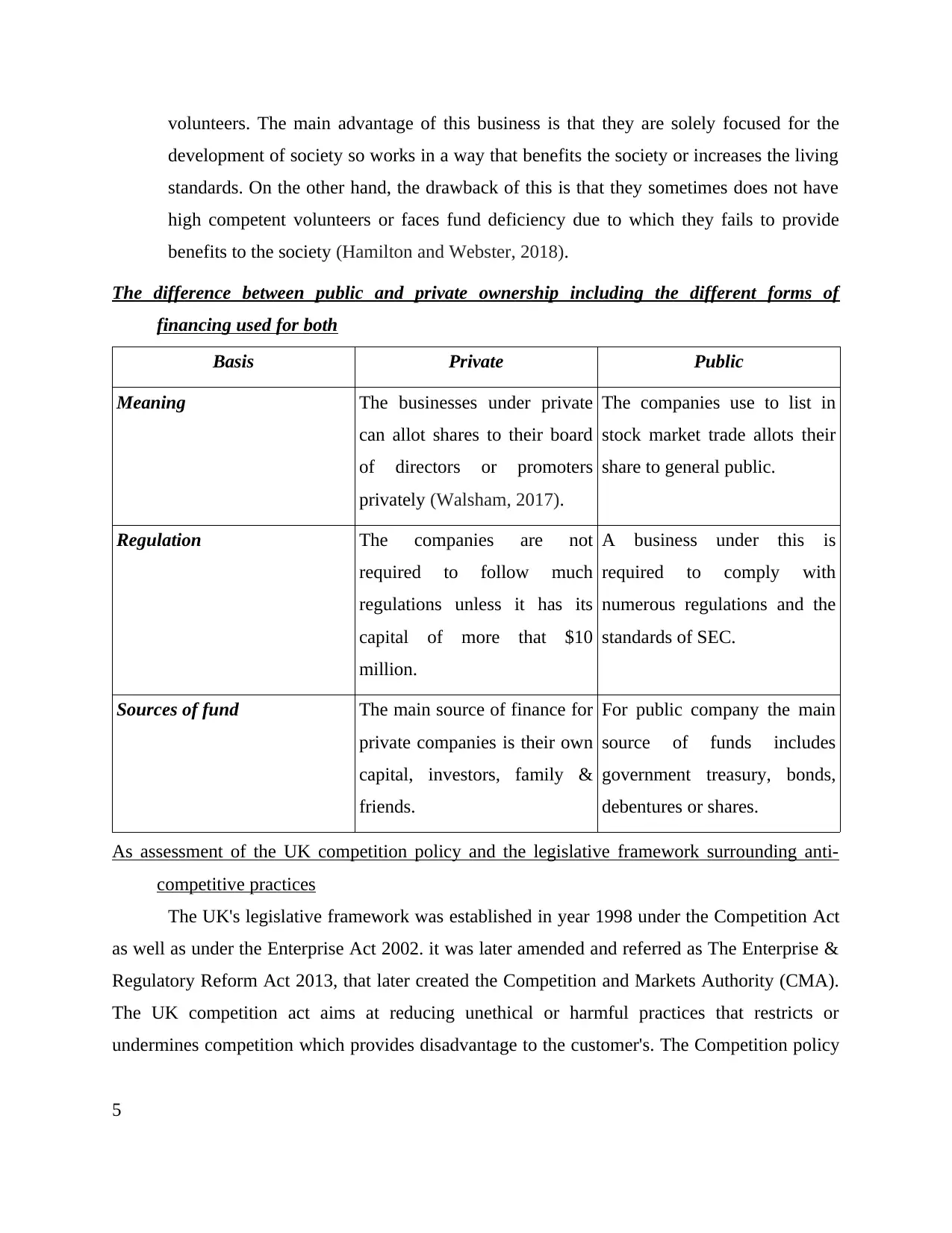
volunteers. The main advantage of this business is that they are solely focused for the
development of society so works in a way that benefits the society or increases the living
standards. On the other hand, the drawback of this is that they sometimes does not have
high competent volunteers or faces fund deficiency due to which they fails to provide
benefits to the society (Hamilton and Webster, 2018).
The difference between public and private ownership including the different forms of
financing used for both
Basis Private Public
Meaning The businesses under private
can allot shares to their board
of directors or promoters
privately (Walsham, 2017).
The companies use to list in
stock market trade allots their
share to general public.
Regulation The companies are not
required to follow much
regulations unless it has its
capital of more that $10
million.
A business under this is
required to comply with
numerous regulations and the
standards of SEC.
Sources of fund The main source of finance for
private companies is their own
capital, investors, family &
friends.
For public company the main
source of funds includes
government treasury, bonds,
debentures or shares.
As assessment of the UK competition policy and the legislative framework surrounding anti-
competitive practices
The UK's legislative framework was established in year 1998 under the Competition Act
as well as under the Enterprise Act 2002. it was later amended and referred as The Enterprise &
Regulatory Reform Act 2013, that later created the Competition and Markets Authority (CMA).
The UK competition act aims at reducing unethical or harmful practices that restricts or
undermines competition which provides disadvantage to the customer's. The Competition policy
5
development of society so works in a way that benefits the society or increases the living
standards. On the other hand, the drawback of this is that they sometimes does not have
high competent volunteers or faces fund deficiency due to which they fails to provide
benefits to the society (Hamilton and Webster, 2018).
The difference between public and private ownership including the different forms of
financing used for both
Basis Private Public
Meaning The businesses under private
can allot shares to their board
of directors or promoters
privately (Walsham, 2017).
The companies use to list in
stock market trade allots their
share to general public.
Regulation The companies are not
required to follow much
regulations unless it has its
capital of more that $10
million.
A business under this is
required to comply with
numerous regulations and the
standards of SEC.
Sources of fund The main source of finance for
private companies is their own
capital, investors, family &
friends.
For public company the main
source of funds includes
government treasury, bonds,
debentures or shares.
As assessment of the UK competition policy and the legislative framework surrounding anti-
competitive practices
The UK's legislative framework was established in year 1998 under the Competition Act
as well as under the Enterprise Act 2002. it was later amended and referred as The Enterprise &
Regulatory Reform Act 2013, that later created the Competition and Markets Authority (CMA).
The UK competition act aims at reducing unethical or harmful practices that restricts or
undermines competition which provides disadvantage to the customer's. The Competition policy
5
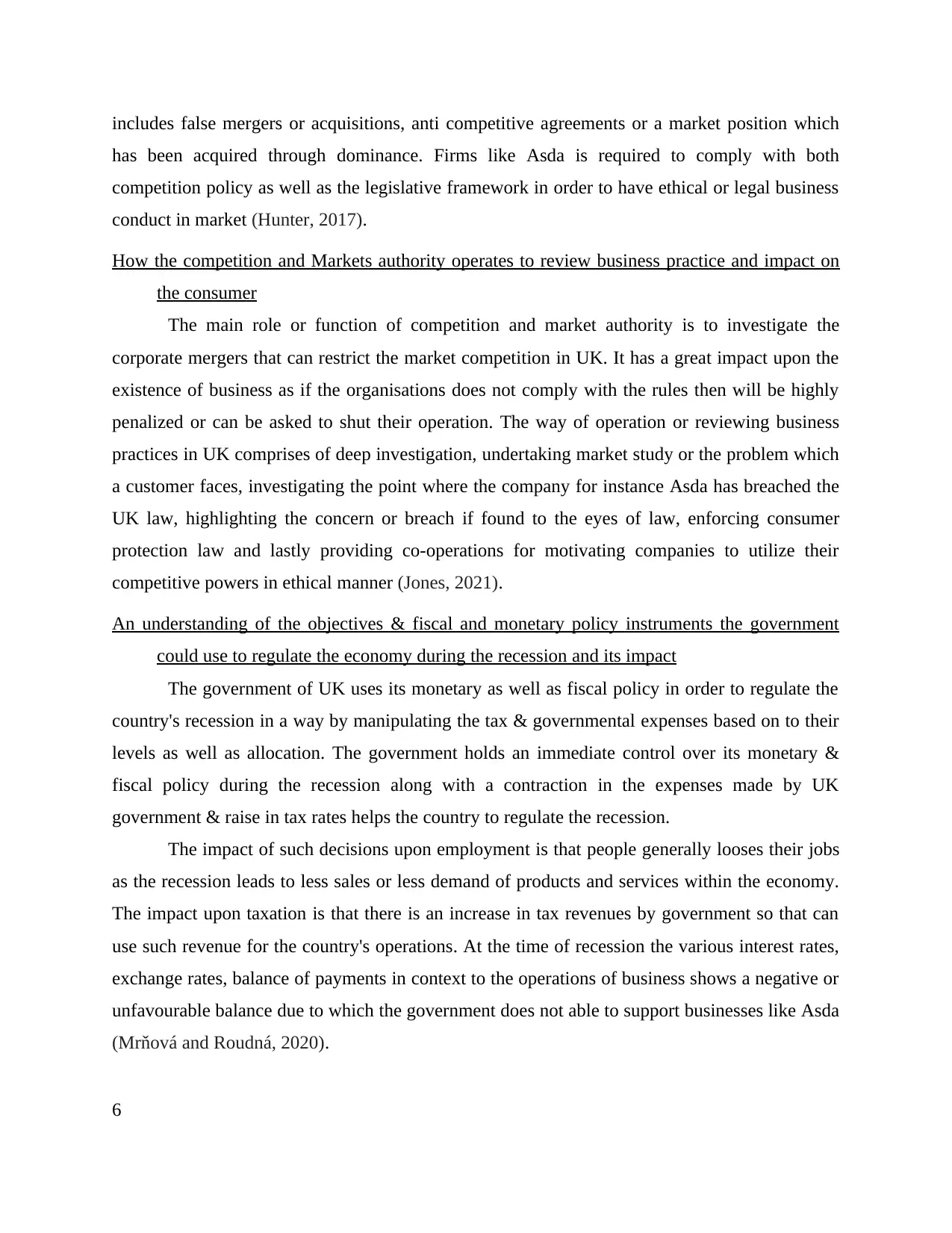
includes false mergers or acquisitions, anti competitive agreements or a market position which
has been acquired through dominance. Firms like Asda is required to comply with both
competition policy as well as the legislative framework in order to have ethical or legal business
conduct in market (Hunter, 2017).
How the competition and Markets authority operates to review business practice and impact on
the consumer
The main role or function of competition and market authority is to investigate the
corporate mergers that can restrict the market competition in UK. It has a great impact upon the
existence of business as if the organisations does not comply with the rules then will be highly
penalized or can be asked to shut their operation. The way of operation or reviewing business
practices in UK comprises of deep investigation, undertaking market study or the problem which
a customer faces, investigating the point where the company for instance Asda has breached the
UK law, highlighting the concern or breach if found to the eyes of law, enforcing consumer
protection law and lastly providing co-operations for motivating companies to utilize their
competitive powers in ethical manner (Jones, 2021).
An understanding of the objectives & fiscal and monetary policy instruments the government
could use to regulate the economy during the recession and its impact
The government of UK uses its monetary as well as fiscal policy in order to regulate the
country's recession in a way by manipulating the tax & governmental expenses based on to their
levels as well as allocation. The government holds an immediate control over its monetary &
fiscal policy during the recession along with a contraction in the expenses made by UK
government & raise in tax rates helps the country to regulate the recession.
The impact of such decisions upon employment is that people generally looses their jobs
as the recession leads to less sales or less demand of products and services within the economy.
The impact upon taxation is that there is an increase in tax revenues by government so that can
use such revenue for the country's operations. At the time of recession the various interest rates,
exchange rates, balance of payments in context to the operations of business shows a negative or
unfavourable balance due to which the government does not able to support businesses like Asda
(Mrňová and Roudná, 2020).
6
has been acquired through dominance. Firms like Asda is required to comply with both
competition policy as well as the legislative framework in order to have ethical or legal business
conduct in market (Hunter, 2017).
How the competition and Markets authority operates to review business practice and impact on
the consumer
The main role or function of competition and market authority is to investigate the
corporate mergers that can restrict the market competition in UK. It has a great impact upon the
existence of business as if the organisations does not comply with the rules then will be highly
penalized or can be asked to shut their operation. The way of operation or reviewing business
practices in UK comprises of deep investigation, undertaking market study or the problem which
a customer faces, investigating the point where the company for instance Asda has breached the
UK law, highlighting the concern or breach if found to the eyes of law, enforcing consumer
protection law and lastly providing co-operations for motivating companies to utilize their
competitive powers in ethical manner (Jones, 2021).
An understanding of the objectives & fiscal and monetary policy instruments the government
could use to regulate the economy during the recession and its impact
The government of UK uses its monetary as well as fiscal policy in order to regulate the
country's recession in a way by manipulating the tax & governmental expenses based on to their
levels as well as allocation. The government holds an immediate control over its monetary &
fiscal policy during the recession along with a contraction in the expenses made by UK
government & raise in tax rates helps the country to regulate the recession.
The impact of such decisions upon employment is that people generally looses their jobs
as the recession leads to less sales or less demand of products and services within the economy.
The impact upon taxation is that there is an increase in tax revenues by government so that can
use such revenue for the country's operations. At the time of recession the various interest rates,
exchange rates, balance of payments in context to the operations of business shows a negative or
unfavourable balance due to which the government does not able to support businesses like Asda
(Mrňová and Roudná, 2020).
6
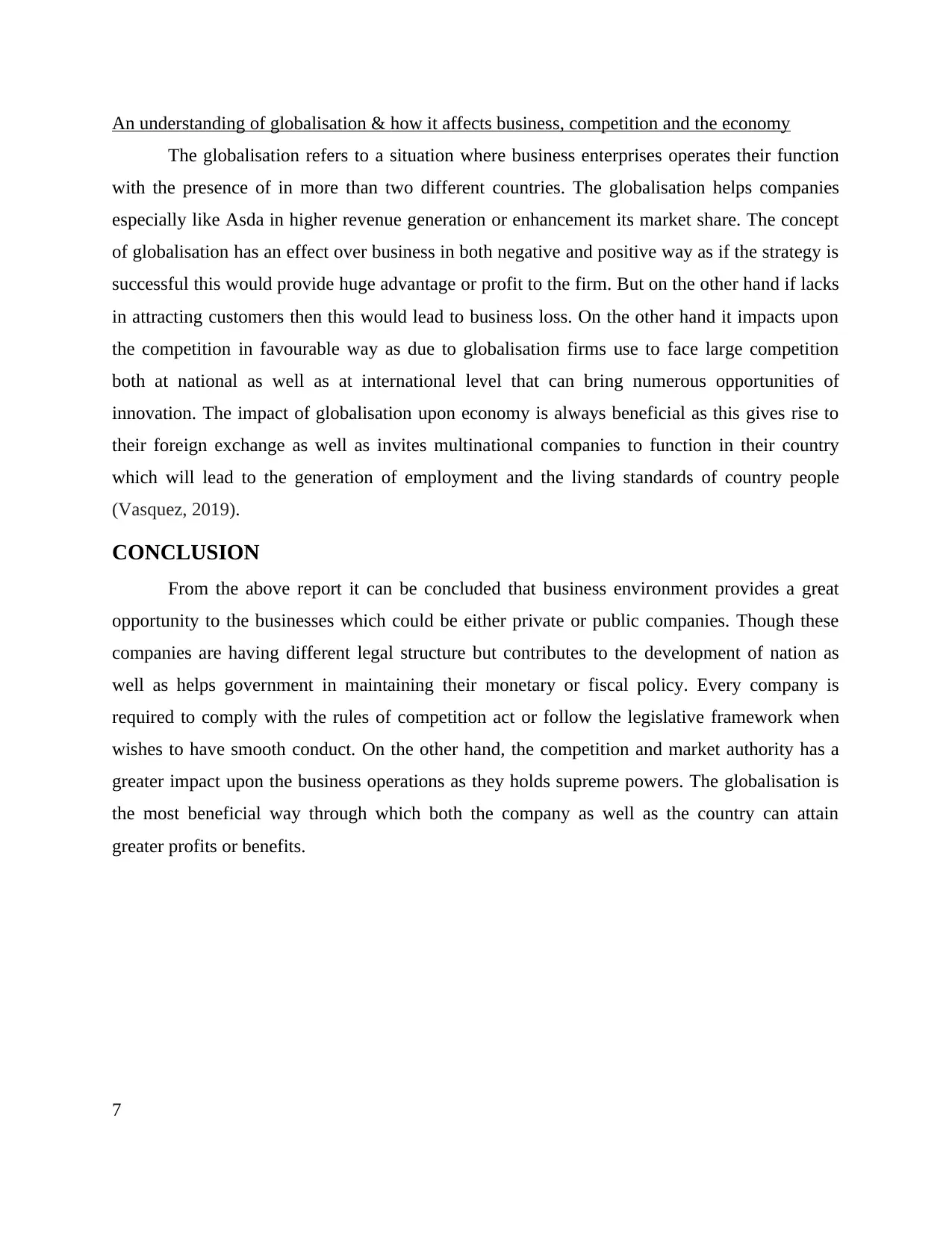
An understanding of globalisation & how it affects business, competition and the economy
The globalisation refers to a situation where business enterprises operates their function
with the presence of in more than two different countries. The globalisation helps companies
especially like Asda in higher revenue generation or enhancement its market share. The concept
of globalisation has an effect over business in both negative and positive way as if the strategy is
successful this would provide huge advantage or profit to the firm. But on the other hand if lacks
in attracting customers then this would lead to business loss. On the other hand it impacts upon
the competition in favourable way as due to globalisation firms use to face large competition
both at national as well as at international level that can bring numerous opportunities of
innovation. The impact of globalisation upon economy is always beneficial as this gives rise to
their foreign exchange as well as invites multinational companies to function in their country
which will lead to the generation of employment and the living standards of country people
(Vasquez, 2019).
CONCLUSION
From the above report it can be concluded that business environment provides a great
opportunity to the businesses which could be either private or public companies. Though these
companies are having different legal structure but contributes to the development of nation as
well as helps government in maintaining their monetary or fiscal policy. Every company is
required to comply with the rules of competition act or follow the legislative framework when
wishes to have smooth conduct. On the other hand, the competition and market authority has a
greater impact upon the business operations as they holds supreme powers. The globalisation is
the most beneficial way through which both the company as well as the country can attain
greater profits or benefits.
7
The globalisation refers to a situation where business enterprises operates their function
with the presence of in more than two different countries. The globalisation helps companies
especially like Asda in higher revenue generation or enhancement its market share. The concept
of globalisation has an effect over business in both negative and positive way as if the strategy is
successful this would provide huge advantage or profit to the firm. But on the other hand if lacks
in attracting customers then this would lead to business loss. On the other hand it impacts upon
the competition in favourable way as due to globalisation firms use to face large competition
both at national as well as at international level that can bring numerous opportunities of
innovation. The impact of globalisation upon economy is always beneficial as this gives rise to
their foreign exchange as well as invites multinational companies to function in their country
which will lead to the generation of employment and the living standards of country people
(Vasquez, 2019).
CONCLUSION
From the above report it can be concluded that business environment provides a great
opportunity to the businesses which could be either private or public companies. Though these
companies are having different legal structure but contributes to the development of nation as
well as helps government in maintaining their monetary or fiscal policy. Every company is
required to comply with the rules of competition act or follow the legislative framework when
wishes to have smooth conduct. On the other hand, the competition and market authority has a
greater impact upon the business operations as they holds supreme powers. The globalisation is
the most beneficial way through which both the company as well as the country can attain
greater profits or benefits.
7
Paraphrase This Document
Need a fresh take? Get an instant paraphrase of this document with our AI Paraphraser
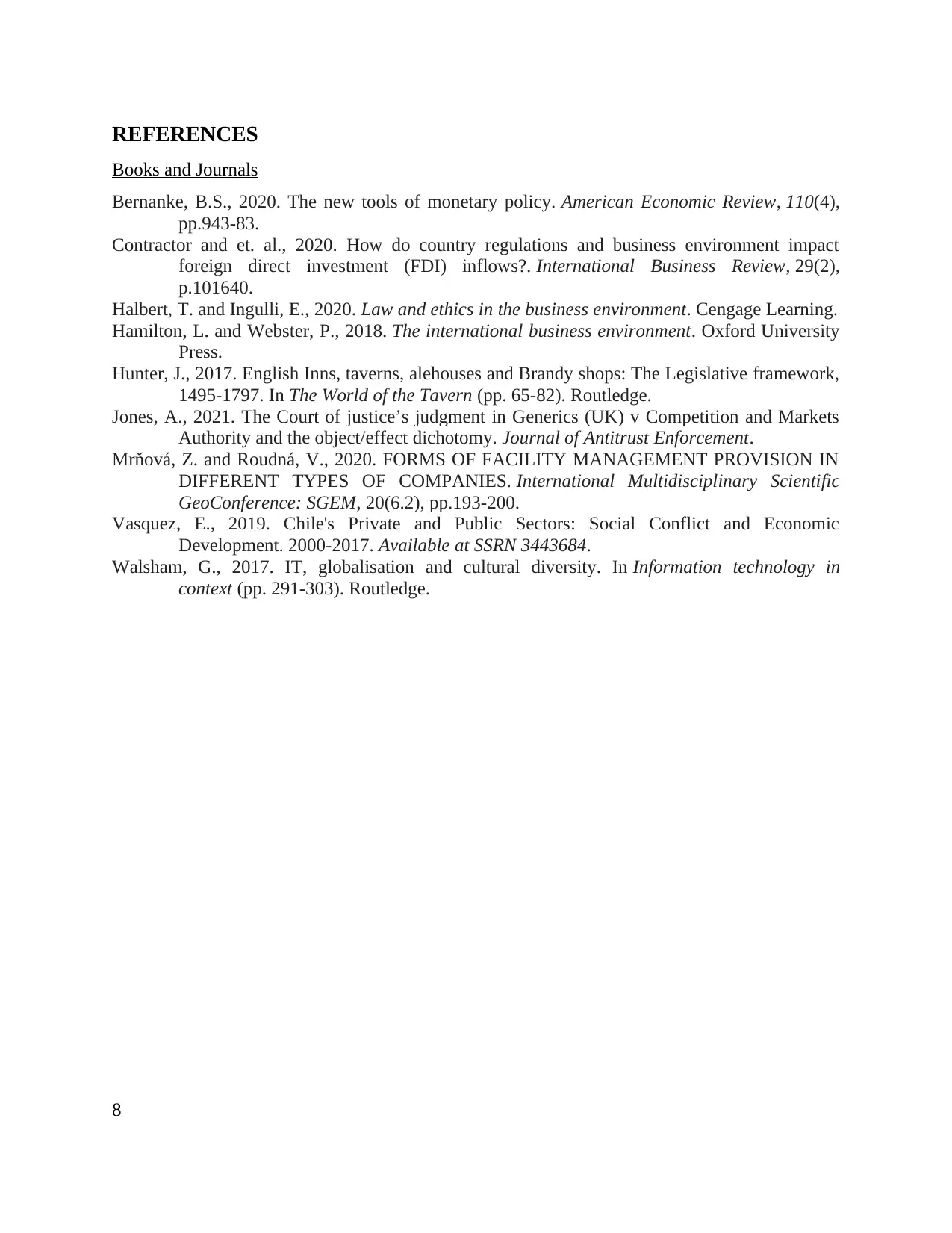
REFERENCES
Books and Journals
Bernanke, B.S., 2020. The new tools of monetary policy. American Economic Review, 110(4),
pp.943-83.
Contractor and et. al., 2020. How do country regulations and business environment impact
foreign direct investment (FDI) inflows?. International Business Review, 29(2),
p.101640.
Halbert, T. and Ingulli, E., 2020. Law and ethics in the business environment. Cengage Learning.
Hamilton, L. and Webster, P., 2018. The international business environment. Oxford University
Press.
Hunter, J., 2017. English Inns, taverns, alehouses and Brandy shops: The Legislative framework,
1495-1797. In The World of the Tavern (pp. 65-82). Routledge.
Jones, A., 2021. The Court of justice’s judgment in Generics (UK) v Competition and Markets
Authority and the object/effect dichotomy. Journal of Antitrust Enforcement.
Mrňová, Z. and Roudná, V., 2020. FORMS OF FACILITY MANAGEMENT PROVISION IN
DIFFERENT TYPES OF COMPANIES. International Multidisciplinary Scientific
GeoConference: SGEM, 20(6.2), pp.193-200.
Vasquez, E., 2019. Chile's Private and Public Sectors: Social Conflict and Economic
Development. 2000-2017. Available at SSRN 3443684.
Walsham, G., 2017. IT, globalisation and cultural diversity. In Information technology in
context (pp. 291-303). Routledge.
8
Books and Journals
Bernanke, B.S., 2020. The new tools of monetary policy. American Economic Review, 110(4),
pp.943-83.
Contractor and et. al., 2020. How do country regulations and business environment impact
foreign direct investment (FDI) inflows?. International Business Review, 29(2),
p.101640.
Halbert, T. and Ingulli, E., 2020. Law and ethics in the business environment. Cengage Learning.
Hamilton, L. and Webster, P., 2018. The international business environment. Oxford University
Press.
Hunter, J., 2017. English Inns, taverns, alehouses and Brandy shops: The Legislative framework,
1495-1797. In The World of the Tavern (pp. 65-82). Routledge.
Jones, A., 2021. The Court of justice’s judgment in Generics (UK) v Competition and Markets
Authority and the object/effect dichotomy. Journal of Antitrust Enforcement.
Mrňová, Z. and Roudná, V., 2020. FORMS OF FACILITY MANAGEMENT PROVISION IN
DIFFERENT TYPES OF COMPANIES. International Multidisciplinary Scientific
GeoConference: SGEM, 20(6.2), pp.193-200.
Vasquez, E., 2019. Chile's Private and Public Sectors: Social Conflict and Economic
Development. 2000-2017. Available at SSRN 3443684.
Walsham, G., 2017. IT, globalisation and cultural diversity. In Information technology in
context (pp. 291-303). Routledge.
8

9
1 out of 9
Related Documents
Your All-in-One AI-Powered Toolkit for Academic Success.
+13062052269
info@desklib.com
Available 24*7 on WhatsApp / Email
![[object Object]](/_next/static/media/star-bottom.7253800d.svg)
Unlock your academic potential
© 2024 | Zucol Services PVT LTD | All rights reserved.




